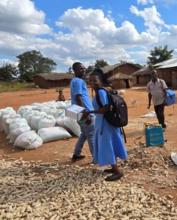Malawi’s Measles-Rubella Campaign: A United Front Against Outbreak
In the wake of sporadic measles outbreaks that gripped Malawi from late 2024 into mid-2025, the country mounted a swift and coordinated response. Declared a Grade 2 public health event in November 2024, the outbreak spread across ten districts, with six districts remaining actively affected by April 2025.
Faced with limited domestic resources, Malawi’s Ministry of Health, with support from WHO Country Office applied to the Measles & Rubella Partnership Outbreak Response Fund for funding support. The approval of this request paved the way for a reactive mass vaccination campaign targeting over 2.3 million children aged 9 months to 9 years in six high-risk districts: Lilongwe, Blantyre, Nkhotakota, Mangochi, Salima, and Ntcheu.
The campaign, conducted from June 2nd to 6th, 2025, was a massive undertaking involving over 5,700 vaccination teams and more than 20,000 trained health workers. Planning and coordination were meticulous, with national and district-level task forces overseeing operations. Emergency Operations Center meetings ensured real-time decision-making, while microplanning workshops helped validate target populations and map out vaccination sites. Training cascaded from national level to district-level facilitators, equipped teams with the skills needed for effective implementation. Social mobilization played a pivotal role in the campaign’s success. Led by the Health Education Unit and District Health Promotion Officers, community engagement efforts included radio broadcasts, town criers, drama troupes, and visibility materials tailored to gender and cultural contexts. Village leaders and health workers rallied communities, ensuring widespread awareness and participation. Monitoring and supervision were rigorous, with daily data reviews and real-time reporting via the ODK app. Supervisors used Rapid Convenience Methodology to identify missed children and conducted mop-up activities in 28 catchment areas, ensuring no child was left behind.
From the classrooms of Lukuni in the Lilongwe District to the hard-to-reach farmlands of Makioni in the Salima District, health teams used diverse strategies including house to house, temporary sites in high traffic areas and statics sites in health facilities to reach children with measles – rubella vaccine, vitamin A and preventive messages. Community patronage was high evidenced by long queues at most vaccination sites with eager care givers including males willing to have their children vaccinated.
In Chifonda village, approximately 65 kilometres from the district health office in Salima, Gazaneal Lazurus brought his daughter for vaccination while his wife participated in communal harvesting activities. He highlighted” Vaccination of children is a shared responsibility for both parents. It should not be left to women alone.”
Despite logistical hurdles, including delayed delivery of injection devices, fuel shortages, and limited Vitamin A stocks, the campaign achieved remarkable results. Over 2.2 million children were vaccinated, reaching 97% of the target population. Each district surpassed the 95% coverage goal. Notably, the campaign reached over 94,000 zero-dose children and 267,000 under-immunized children, significantly closing immunity gaps in underserved areas.
The integrated delivery of Vitamin A supplementation reached 72% of the target population, although coverage varied due to stock limitations.
The impact of the campaign was immediate and profound. Epicurve data showed a sharp decline in measles cases following the intervention, with transmission interrupted across all six districts with zero reporting of measles cases achieved in by the end of July across all six districts. The campaign also strengthened routine immunization systems, improved surveillance, and fostered community trust in public health initiatives.
Donor support was instrumental in this success. The Measles & Rubella Partnership, comprising WHO, UNICEF, US CDC, the UN Foundation, and the American Red Cross, provided critical funding for vaccines, operational costs, and equipment. Their timely intervention enabled Malawi to respond effectively and protect its children from a preventable disease. Looking ahead, the Ministry of Health plans to use insights from the campaign to inform future strategies. Root cause analyses and recovery plans developed through an after-action review will guide investments in routine immunization, surveillance, and outbreak preparedness.
Malawi’s Measles-Rubella campaign stands as a testament to what can be achieved when communities, governments, and global partners unite against a common threat.
bunyao [at] who.int (bunyao[at]who[dot]int)
+265 999 930 280

